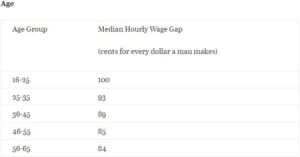In light of the #Op2Op campaign, I wanted to provide a different perspective to the issue of the gender pay gap – one of good news! My colleagues at GenFKD have also done some explicating of the issue.
While some argue for action through government mandates, I tend to believe that, with a bit of cultural pressure, the gender pay gap has been shrinking on its own.
Sorry FOX, it’s not a myth
We’ve seen it everywhere: “Women make $0.78 to the man’s $1.00!”, “Women make 28 percent less than men in the workplace!” and all other variations of the same argument. Contrary to popular conservative belief, the gap is not a myth. Women do make that much less than men in the United States. When adding up all the salaries of women and dividing it by the amount of women and doing the same thing for males, the gap is crystal clear.
However, there are a couple caveats when looking at this number. This does not take into account age groups, education levels, and years of experience. Dr. Andrew Chamberlain, the chief economist from Glassdoor, used evidence from the Glassdoor salary data to “demystify the gender pay gap.” Not only does the study take into account age, education, and experience, but it dives deeper to control for same job title, location, and employer.
A woman that is 45 years old with a Ph.D. in electrical engineering, working for Lockheed Martin in Orlando, Fla. should not be compared to a 24-year-old male basket-weaving major, working for Starbucks, in northern Oregon, right? You need to find a way to hold those extra variables constant and compare people with similar attributes.
So, by controlling the effect of these attributes, the statistician is able to compare apples to apples. When these statistical controls are added, the gap still exists in the United States but falls to to 5.4 percent.
Generational gap-shrinking
A report from the DeVoe Moore Center at Florida State University, analyzed the wage gap of Florida by breaking it down by age, occupation and education. For ages 25-35, the gap shrinks to seven percent.
The rise of the millennial has come with a paradigm shift laden with not only technological advances, but cultural advances as well. Gen Y is more informed, entrepreneurial, more accepting of different cultures, and slowly, taking over the role of employer by storm, which results in the shrinking of the gap for the newer generations.
Today, women are more likely to have a Bachelor’s degree than men, but getting to this point has been a slow process.
“Ma, I’m going to college!”
In a report by the National Bureau of Economic Research summarized here, the transition of women heading to college has been accelerated and decelerated by science, politics and war.
Women flooded the workforce during World War 2, while men were overseas fighting the good fight. However, the soldiers came back and straight to college with their G.I. bills. During this time, there were 2.3 men for every woman in college. Another halt to the shrinking of the college education gap was the Vietnam War; a sharp increase of men enrolling in universities from 1963 to 1968 shows that men were avoiding the draft by going to college.
Social norms of the time pressured female college students to pursue majors in occupations like teaching and social work. Even further, these norms also pressured many women to treat college as an opportunity not to find a career path, but a husband with whom to settle down. This resulted in marriage and children one year after graduation—baby boom style.
Although this was the norm from the ‘40s through the ‘60s, by 1970, a generation of women decided en masse to reject the patriarchal norms pressed down upon them and aspired for careers across the industry spectrum.
In addition, the introduction of birth control allowed women to better plan their futures. They could now postpone having children for more years after graduation. This has allowed for the wage premium, or relationship between having a college degree and how much a person makes, to increase, especially for women since the early 80s.
Our take
The wage premium has increased, but there is no doubt that women still face gender discrimination in the labor force. The demands by the media and modern day feminism is that women should get equal pay for equal work, and rightly so!
However, the true extent of the gap varies due to a variety of factors and data suggests that the gap is consistently closing as the workforce becomes younger, more socially liberal and more educated.
This type of progressivism does not happen overnight, because employers still command who they decide to hire and decide what they will pay. Nevertheless, progress is happening.
As women continue to dominate the university population and (although still underrepresented in some majors) continue increasing their enrollment in the STEM field that offer lucrative careers after graduation, we will see the pay gap slowly disappear, if not slightly reverse. (I’m pretty optimistic.)
The status quo of women’s traditional role in society is hard to change, but rest assured, Gen Y’s female offspring will continue to see this wage gap shrink. And, if you’re wondering where the women CEOs are, just look around your MBA program. A bunch of them are right there next to you.
Have something to add to this story? Comment below or join the discussion on Facebook.
Header image: Getty











































